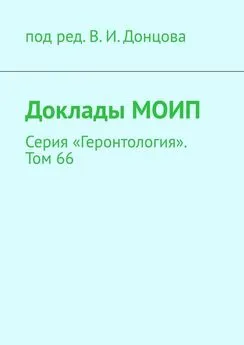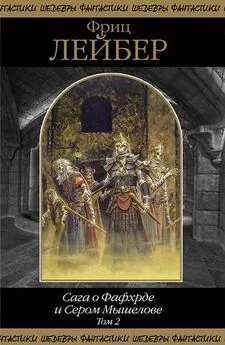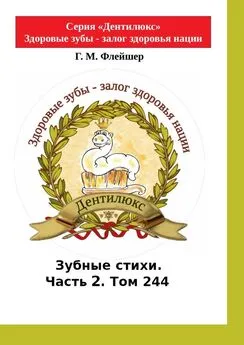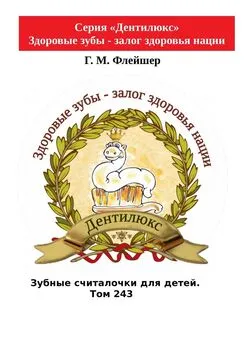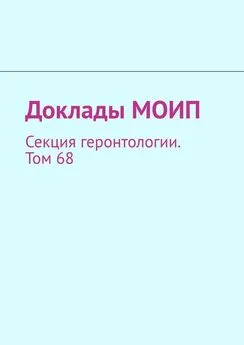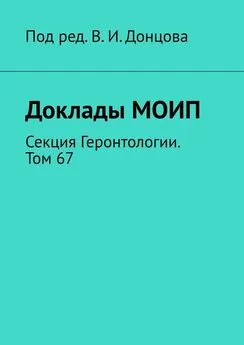В. Донцов - Доклады МОИП. Серия «Геронтология». Том 66
- Название:Доклады МОИП. Серия «Геронтология». Том 66
- Автор:
- Жанр:
- Издательство:неизвестно
- Год:неизвестен
- ISBN:9785005043306
- Рейтинг:
- Избранное:Добавить в избранное
-
Отзывы:
-
Ваша оценка:
В. Донцов - Доклады МОИП. Серия «Геронтология». Том 66 краткое содержание
Доклады МОИП. Серия «Геронтология». Том 66 - читать онлайн бесплатно ознакомительный отрывок
Интервал:
Закладка:
К естественному старению можно относиться как к обычному полисиндромному заболеванию, что открывает возможность своевременной профилактики и коррекции старения официально разрешенными средствами, доступными обычному врачу.
Подход к естественному старению как к полисиндромному заболеванию дает основания для ввода наиболее эффективных средств коррекции этого заболевания – геропротекторов в современную Фармакопею.
Литература
Babaeva A.G. Reparative processes and immunity. Izv Akad Nauk Ser Biol. 1999. 3: 261—269. Review. Russian.
Babaeva A.G., Zuev V.A. Transfer of signs of aging to young mice by splenic lymphoid cells from old syngeneic donors..Bull. exp. biol. med. 2007. 1441: 89—90.
Barzilai N., Crandall J.P., Kritchevsky S.B. and Espeland, M.A. Metformin as a Tool to Target Aging. Cell Metab. 2016. 236: 1060—1065.
Blumenthal H.T. The aging-dise as e dichotomy: true or false J. Gerontol. Med. Sci. 2006. 58A: 138—145.
Bulterijs S. The future of longevity. Pan Eur. Netw. 2012. 5: 116—117.
Bulterijs S., Hull R.S., Bjork V.C. et al. It is time to classify biological aging as a disease. Front. Genet. 2016. 6: 205.
Donmez G., Guarente L. Aging and disease: connections to sirtuins. Aging Cell. 2010. 9, 285—290.
Dontsov V.I. Lymphocyte regulation of cellular growth in somatic tissues and a new immune theory of aging. Fiziol Cheloveka. 1998. 241: 82—87. Russian.
Dontsov V.I., Krut`ko V.N. Biological age as a method for systematic assessment of ontogenetic changes in the state of an organism. Russian journal of developmental biology. 2015. 465: 246—253.
Flurkey K., Astle C.M., Harrison D.E. Life Extension by Diet Restriction and N-Acetyl-L-Cysteine in Genetically Heterogeneous Mice. J Gerontol A Biol Sci Med Sci 2010. 65A: 1275—1284
Gems D. What is an anti-aging treatment? Exp. Gerontol. 2014. 58: 14—18.
Harrison D.E., Strong R., Sharp Z.D. et al. Rapamycin fed late in life extends lifespan in genetically heterogeneous mice. Nature. 2009. 460, 392—395.
Hayflick L. Entropy explains aging, genetic determinism explains longevity, and undefined terminology explains misunderstanding both. PloS. Genet. 2007. 3: 220—224.
Jones, D. P. Redox theory of aging. Redox Biol. 2015. 5: 71—79.
Kalra S., Jacob J.J., Gupta Y. Newer antidiabetic drugs and calorie restriction mimicry. Indian J Endocrinol Metab.2016. 201: 142—146.
Khansari D.H., Gustad T. Effect of long-term, low-dose growth hormone therapy on immune function and life expectancy of mice. Mech. Ageing Dev. 1991. 57: 87—100.
Khalyavkin A.V., Krut’ko V.N. Early Thymus Involution-Manifestation of an Aging Program or a Program of Development? Biochemistry Moscow. 2015. 8012: 1622—1625.
Khokhlov A.N. Impairment of regeneration in aging: appropriateness or stochastics?// Biogerontology. 2013. 146: 703—708.
Kirkwood T.B., Melov S. On the programmed/non-programmed nature of ageing within the life history. 2011. Curr. biol. 2118: 701—707.
Krut’ko V.N, Dontsov V.I., Zakhar’iashcheva O.V. The system theory of aging: methodological principles, basic tenets and applications. Aviakosm Ekolog Med. 2009. 431: 12—19. Review. Russian.
Krut’ko V.N., Dontsov V.I., Khalyavkin A.V. Effect of alphafetoprotein on lifespan of old mice. Biochemistry Moscow. 2016. 8112: 1477—1479.
Liochev S.I. Which is the most significant cause of aging? Antioxidants Basel.2015. 174: 793—810.
Lustgarten M.S. Classifying Aging As a Disease: The Role of Microbes. Front Genet. 2016. 1, 7: 212; eCollection 2016.
Marengoni A., Angleman S., Melis R. et al. Aging with multimorbidity: a systematic review of the literature. Ageing Res. Rev. 2011. 1 (10): 430—439.
Moskalev A., Chernyagina E., Tsvetkov V. et al. Developing criteria for evaluation of geroprotectors as a key stage toward translation to the clinic. Aging Cell. 2016. 15: 407—415.
Moskalev A., Chernyagina E., Kudryavtseva1 A. et al. Geroprotectors: A Unified Concept and Screening Approaches. Aging and Disease.2017. 834: 1—10.
Nikolai S., Pallauf K., Huebbe P. et al. Energy restriction and potential energy restriction mimetics. Nutr Res Rev. 2015. 282: 100—120.
Rattan S.I.S. Aging is not a disease: implications for intervention. Aging Dis. 2014. 5: 196—202.
Pinto M., Moraes C.T. Mechanisms linking mtDNA damage and aging.Free Radic Biol Med. 2015. 85: 250—258.
Rando T.A., Chang H.Y. Aging, rejuvenation, and epigenetic reprogramming: resetting the aging clock. Cell. 2012. 1481—2: 46—57.
Roth G.S., Ingram D.K. Manipulation of health span and function by dietary caloric restriction mimetics. Ann N Y Acad Sci. 2016. 3631: 5—10.
Spindler S.R. Review of the literature and suggestions for the design of rodent survival studies for the identification of compounds that increase health and life span. Age. 2012. 341: 111—120.
Strong R., Miller R.A., Astle C.M. et al. Nordihydroguaiaretic acid and aspirin increase lifespan of genetically heterogeneous male mice. Aging Cell. 2008. 7: 641—650
Zhavoronkov A., Bhullar B. Classifying aging as a disease in the context of ICD-11. Front Genet. 2015. 4, 6: 326.
Zhavoronkov A., Moskalev A. Editorial: Should We Treat Aging as a Disease? Academic, Pharmaceutical, Healthcare Policy, and Pension Fund Perspectives. Front Genet. 2016. 16, 7: 17.
Walker R. F. Developmental theory of aging revisited: focus on causal and mechanistic links between development and senescence. Rejuvenation res. 2011. 144: 429—436.
A DEVELOPMENT THE TYPICAL FOR COMMON DISEASE SYNDROMES IN THE COURSE OF NATURAL AGING AND THE VALIDITY OF THEIR CORRECTION USUAL MEDICAL MEANS
V. N. Krut’ko, V. I. Dontsov
A General approach to aging is possible only on the basis of the General System theory of aging. The system theory of aging is based on the General Model of aging of Biosystems. This model includes aging Syndromes as the most important level of aging development and is the same as the typical syndromes for any disease. This allows us to diagnose, treat and prevent aging syndomes as syndromes of any disease. Additional is the development of Age-related diseases, which also requires diagnosis and prevention also during aging. All this allows an ordinary doctor to treat the manifestations of aging as manifestations of diseases. This makes the effects on aging accessible and understandable to the Clinician.
СТАРОСТЬ КАК ВОЗРАСТ-ЗАВИСИМОЕ ОБЩЕСИСТЕМНОЕ МУЛЬТИФАКТОРИАЛЬНОЕ ЗАБОЛЕВАНИЕ, ПАТОГЕНЕЗ КОТОРОГО СООТВЕТСТВУЕТ БИОЛОГИЧЕСКОМУ ПРОЦЕССУ СТАРЕНИЯ
Б. А. Кауров
Обсуждается вопрос о взаимоотношении таких понятий как «старость» и «болезнь». Сделана попытка рассмотреть этот вопрос с формальной точки зрения, исходя из присущих этим понятиям свойств. Показано, что старость можно рассматривать как общесистемное мультифакториальное возраст-зависимое заболевание, так как оно соответствует всем формальным критериям, предъявляемым для признания данного состояния болезнью. Также показана взаимосвязь старости с другими возраст-зависимыми заболеваниями и онтогенезом.
Конец ознакомительного фрагмента.
Текст предоставлен ООО «ЛитРес».
Прочитайте эту книгу целиком, купив полную легальную версию на ЛитРес.
Безопасно оплатить книгу можно банковской картой Visa, MasterCard, Maestro, со счета мобильного телефона, с платежного терминала, в салоне МТС или Связной, через PayPal, WebMoney, Яндекс.Деньги, QIWI Кошелек, бонусными картами или другим удобным Вам способом.
Интервал:
Закладка:
